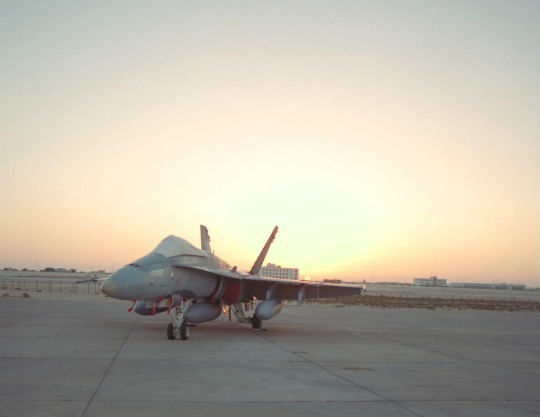By retired Capt David Deere | January 25, 2016
Estimated reading time 7 minutes, 12 seconds.
A CF-188 Hornet rests on the tarmac as the Qatar sun sets in the background on Oct. 9, 1990 during Operation Scimitar. DND Photo
Twenty-five years ago, the United States-led Operation Desert Storm began with the launch of aerial bombing attacks against Iraq on Jan. 17, 1991. Canada’s air contribution to the Gulf War had begun in the autumn of 1990 when Canadian CF-188 Hornets and support staff deployed to the Gulf region under Operation Scimitar to provide top cover for Canadian ships deploying to the region as part of Operation Friction.
The air contingent was officially known as the Canadian Air Task Group – Middle East (CATGME).
As historians Jean Morin and Richard Gimblett describe: “The new formation was produced entirely by 4 Wing, the operational fighter formation at Baden-Söllingen, which immediately began the physical preparation of the mission-bound fighters. . . [The force] required an enlargement of 409 ‘Nighthawk’ with elements of 421 ‘Red Indian’ and 439 ‘Tiger’ Squadrons. . . ”
On Sept. 4, 1990, Prime Minister Brian Mulroney announced the formation of Operation Scimitar. The purpose of the operation was to provide air cover for the two destroyers and the supply ship which had been sent to the Persian Gulf in late August of 1991 as part of Operation Friction, which had been tasked with enforcing the United Nations trade blockade against Iraq.
The size of the commitment began with 18 CF-188 fighter jets, 36 pilots and 255 groundcrew, mainly from 409 Squadron. Some 200 support personnel were assigned to base maintenance and logistics, and a company from the 3rd Battalion, Royal Canadian Regiment at Canadian Forces Base Baden-Soellingen, Germany, was assigned to security.
When Command became aware of the level of intensity for flying operations, the number of pilots was reduced to 28 and groundcrew to 235.
Over a period of two weeks, various countries were approached for hosting a base location. Doha, Qatar, was finally chosen and construction on Canada Dry 1 and 2 began. Interim accommodations were provided by the Gulf Hotel.
In the meantime, personnel in Baden-Soellingen underwent training in preparation for deployment to a war zone. Subjects included nuclear, biological, chemical warfare; desert survival; and small arms.
The pilots were divided into sections consisting of one lead and three wingmen with experience levels spread equitably throughout. Co-ordination in the air was paramount since some pilots were from other squadrons – 421 and 439 in 4 Wing.
Training missions included air combat manoeuvring, low-level air intercept and air-to-air refuelling. On the ground, there were briefings on Iraqi aircraft, surface-to-air (SAM) missile systems, land, sea and air orders of battle, as well as Canadian weapons and tactics.
Deployment of personnel and material started on Oct. 4, 1990. On Oct. 6, the first CF-188s left Baden and escorted a tanker to Akrotiri, Cyprus. The following day, the flight reached Doha, Qatar, and, on the Oct. 8, familiarization flights took place. Oct. 9 saw the first combat air patrols (CAP), and Canada’s mission was underway.
Operational co-ordination was being undertaken at a number of levels to ensure that operational tasking and training missions were carried out with the U.S. Air Force’s F-16s and Qatari Emirate Air Force F-1s and Alpha Jets.
Canadian liaison officers at U.S. Central Command Air Forces in Riyadh, Saudi Arabia, ensured our presence in the daily tasking orders for all our missions. Much work was also done with the U.S. Navy in Bahrain to ensure the correct routings and procedures were followed while we provided air defence over the Gulf.
Within a short time, the lines of communication were sorted out and the operations proceeded with increasing efficiency. Generally, we flew 18 sorties a day: 10 on CAP as well as eight training sorties in order to maintain our proficiency. The CAPs were usually without tanker support, although everyone was able to “tank by opportunity” with U.S. Marine Corps Lockheed C-130 Hercules, U.S. Air Force Boeing KC-10 Extender or Royal Air Force Vickers-Armstrong VC-10 aircraft. While most of the training missions were short air combat manoeuvring/dissimilar air combat training, the CAPs proved to be of longer duration and occurred over the Gulf.
Though we were being sent to a war zone, the rotation plan was not in place at the time of deployment and no-one knew when they were going to get back home. When the rotation schedule was finalized, the groundcrew were the first to be replaced in early to mid-November.
The last personnel from 409 Squadron left Doha on Dec. 21, 1990. They were replaced by a squadron made up of personnel from 409 “Tiger” Squadron and 416 “Lynx” Squadron, who were soon dubbed the “Desert Cats.”
Among the achievements of the early phase of the operation were the establishment of a main operating base, the deployment of 18 CF-188s with required personnel and equipment, 1,100 sorties flown without a flight safety incident, and no casualties were incurred.
The Desert Cats story would not be complete without acknowledging the accomplishments made by 409 “Nighthawk” Squadron and the support units that served with them. They established the extremely strong foundation without which the operation’s success would have been in jeopardy. The multitude of obstacles that were overcome, the individual and group achievements, and the overall contributions were remarkable.
Retired Capt Dave Deere of Calgary, Alta., was a CF-188 pilot during the Gulf War. This article, which has been slightly modified for web publication, is from his book Desert Cats: The Canadian Fighter Squadron in the Gulf War, published in 1991. It was published in Volume 35, No. 1 of Airforce Magazine in 2011, and is translated and reproduced with permission.
The quotation from Major Jean Morin and Lieutenant-Commander Richard H. Gimblett is from their book The Canadian Forces in the Persian Gulf: Operation Friction 1990-1991, published in 1997.

